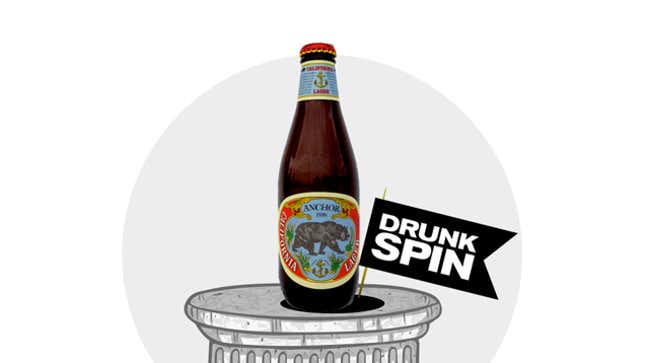
You're getting chubby, and that's mostly because you spend all day looking at slideshows of the "27 Fried-est Foods at the Iowa Tractor Guild's Annual Corn Jousting Festival," which makes you shake your damn head at all those crazy, fat maize warriors and their deep-fried mutton cupcakes as you smirk your way down the elevator to buy your second bagel of the morning from the cart in the lobby of the building where you sit on your ass all day reading slideshows of ... and so forth. That's most of the reason. Another possible reason could be genetics, sure. Another certain reason is that you drink too damn much ale!
Enough with the ale. We should all be drinking more lager. How will this help with our national chubbiness epidemic, you ask? Is beer brewed with bottom-fermenting yeast and then stored at cool temperatures—AKA, lager—inherently lower in calories or otherwise nutritionally superior to the ales that have come to dominate the higher end of the American beerscape? Not at all! Lager's chub-fighting effects are due to more subtle but equally scientific forces. But time for a little history before we get to the science.
The beers that fueled America's first big brewing boom were almost universally lagers made in the German tradition by men named Busch, Schlitz, and Blatz, alongside their Teutonic peers. These beers were good and honest and true, and then Prohibition came in 1920 and screwed everyone but mobsters and bathtub salesmen. When the beer industry was finally allowed to limp back from the grave in 1933, it emerged inevitably changed and weakened: A previously vibrant culture of small, local breweries eventually morphed into the cabal of huge, corporate piss-peddlers that pumped out the awful lagers that came to define American beer for several decades. Then, in 1978, Saint Jimmy Carter signed the law that finally decriminalized home-brewing, which green-lit the basement experimentation that quickly led to the first modern American craft beer movement.
These early craft brewers focused primarily on ales, which generally allow for a broader interpretation of process and therefore flavor. Furthermore, lager-centric German brewing tradition was, of course, full of rules, and that's antithetical to the way we Yanks like to do our innovatin'—particularly in California, where most of the important work was being done in the late '70s and early '80s. Those factors, along with the nasty reputation lager picked up in the dark days when the only bones the macros deigned throw us were quality-neutral tweaks to calorie and alcohol amounts, have led to lager's current fourth-class status among producers and consumers of quality brew.
The most exciting and flavorful American beers are huge stouts and hop-mad India pale ales classified by ever-escalating multipliers of extremity—I've yet to encounter my first quadruple IPA, but I'm sure it's out there—but certain health-conscious brewers are starting to pay a little more attention to the humble lager. They claim to do this out of respect for tradition or a newfound appreciation for lower-proof beer, but the real reason we're starting to see more craft lagers is that brewers know ales make us fat, and being fat makes us die young, and dying young prevents us from buying beer in old age. It's pretty cynical, when you think about it.
While lagers often have fewer calories than the most revered ales, that's not guaranteed by the process (it's just because monster ales have a lot of alcohol; so do monster lagers). The fundamental way lager extends your life is by making you more attractive to prospective mates. A nice, crisp, clean lager will leave your mouth much more kissable than some crazy-ass 11-percent-ABV imperial coffee stout. This improves your romantic prospects, which will lead to a happier life and thus more incentive to stay fit and live long.
Anchor's California Lager is one of the higher-profile beers among this sexy new category. It was introduced in 2012, and it's apparently based on California's original lager. I think we've had enough history for one post; here's the origin myth. I don't care for the more heralded Anchor Steam, but the California Lager came highly recommended from credible sources, so I recently gave it a whirl and came away pretty impressed.
Anchor California pours very pale yellow, with a big head and a bready aroma underlined by a bit of lemon. Cluster hops, a staple of 19th-century California brewing, lend a surprisingly robust spiciness and a light floral edge that elevate this beer above the "good but kinda bland" class of American lagers. It's not a particularly complex or assertive beer by modern West Coast standards, but it's plenty hoppy for an American pale lager, especially for one that pays homage to a pre-Prohibition ancestor.
Bottoms up, tubby!
This is Drunkspin Daily, the Concourse's adequate source for booze news, reviews, and bullshit. We'll be highlighting a beer a day in this space; please leave suggestions below.
Will Gordon loves life and tolerates dissent. He lives in Cambridge, Mass., and has visited all of the other New England states, including, come to think of it, Vermont. Find him on Twitter@WillGordonAgain. Image by Jim Cooke.
The Concourse is Deadspin's home for culture/food/whatever coverage. Follow us on Twitter:@DSconcourse.